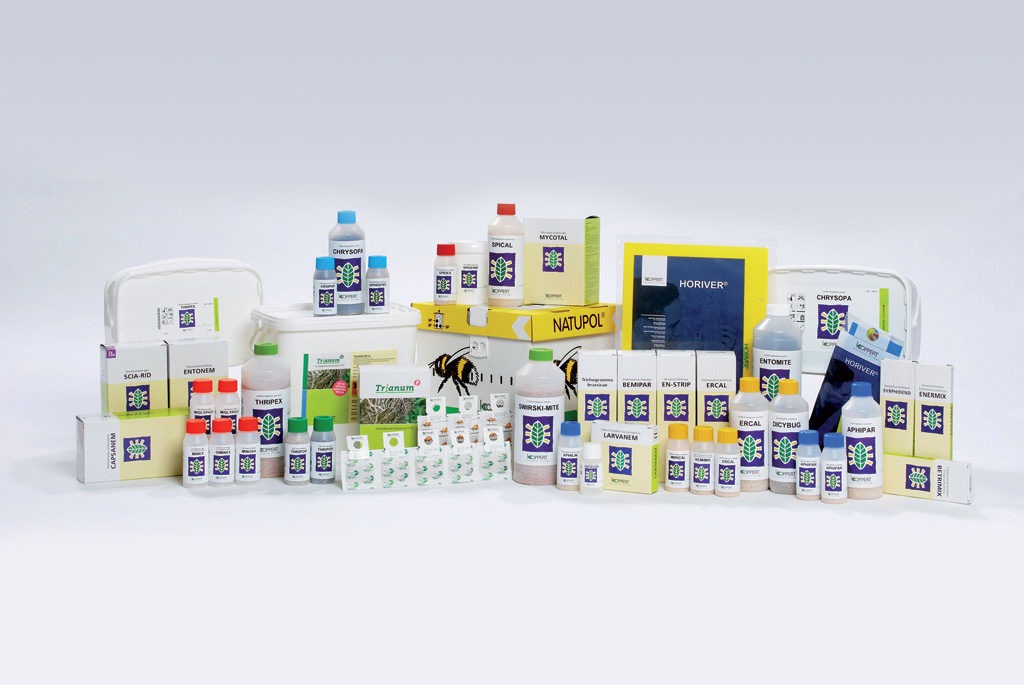Brief description of harmful organisms and the manner of their suppression
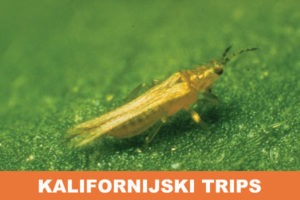
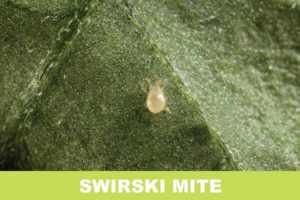
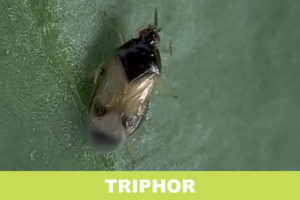
CALIFORNIA TRIPS (Frankliniella occidentalis), DUVANOV TRIPS (Trips tabaci) – can cause major problems in many types of vegetables and fruits. Trips are fed by sucking vegetable juices and selecting the most delicate parts of the plant, and most of all it suits only the fetal fruit. In the event of a strong attack on the leaves, silvery gray ferns with dark green secretions appear, and later the leaves of the leaves and the reduced production of plants appear. Unlike the mosquito-borne viruses that transmit yours and destroy the vectors from the crop of peppers, trips are a transporter of much more persistent viruses.
The most famous virus that transmits trips is the TSWV virus (Tomato bronze virus). Because of all of the above, it is very important to detect the population before, while the number is still small, and for this we use blue Horiver boards. For biological protection Koppert products: SWIRSKI MITE (Amblyseius swirskii) and TRIPHOR L (Orius laevigatus).
LUREM-TR – contains aromatic substances that are irresistible to many types of trips. The main problem with the trips is its presence in the crop several weeks earlier, before we can discover it. By combining lure and blue Horiver plates it is possible to detect trips while its population is very small, which is a great precondition for timely introduction of natural enemies of the trips and establishing the necessary biological balance. In the offer of Green Hit there is also a special blue yellow foil for shells of greenhouses, which is occasionally renewed to reduce the attacks of the tryps, which is the cheapest way of passive defense. Insect-proof protective nets are available for all ventilation openings.
ATTRACKER – Where we do not use biosecurity in suppressing the trips (small plastic tunnels without anti insect network, open field production, prior use of very toxic chemicals), we are forced to standard chemical suppression, which has a limited effect, especially in lush crops where the population is hiding, most often in the armpit of leaves. Chemicals are becoming less and less effective, as the resistance of the trips is increasingly induced. The incorporation of methiocarbus Mesurol, and the subsequent combination of Attracker with chemical preparations based on abamectin-Vertimec, spinosad-Lasser and other active substances have achieved very good results in the suppression of the trips. Attracker contains various sugars, which affect the behavior and movement of the trips, so that moms from their hidden places on the diet and in this way chemical preparations have excellent performance for several hours after application.
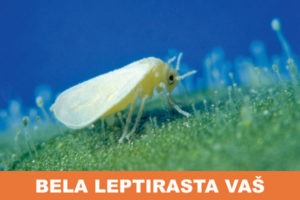
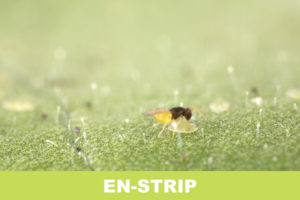
MUSHROOM – A common PAUC (Tetranycus urticae) – yellow, or orange, with two distinct dark spots on the back. The length of an adult is up to 1 mm. Adult shapes in the protected space last name on the construction of the object. For mites, it is characteristic to have high propagation potential, so in favorable conditions (high temperature and low humidity) the population is rising rapidly. The initial attack occurs at a time in the so-called. focuses. The infected leaves have a lot of tiny chlorotic spots, so the leaves become streaky. The characteristic of this mite is the formation of a spider on the back of the leaves, which in cases of strong attack can connect several sheets together. Later the leaves are yellow and dry. With fruitful vegetables the biggest damage causes on cucumber, zucchini, blue eggplant, and less on peppers and tomatoes, in leafy vegetables causing great damage to the celery. In the case of strawberries and raspberries, there are also major damage, so the application of biological protection in the suppression of mites is inevitable. Co-protector for moss biological products: SPICAL (Amblyseius californicus), SPIDEX (Phytoseiulus persimilis), SPIDEND (Feltiella acarisuga).
LOSNE YOURS (Aphis gossypii, Myzus persicae, Aulacorthum solani) – in a protected area cause damage to almost all cultures. Damages are visible on the leaves from which your juices suck, and they become deformed. In this way, dangerous viral diseases are transmitted. Your lupine is a honey dew on which the ants are accumulating and fungal infections develop. Early detection of your popcorn population is done by yellow Horiver plates. Koppert products for biological protection: APHIPAR (Aphidius colemani), APHIPAR-M (Aphidius matricariae), ERVIPAR (Aphidius ervi) and other preparations.
LEISURE MINERS (Liriomyza trifoli, Liriomyza bryoniae) – leaf miners attack cucumbers, tomatoes, blue eggplant and zucchini, while they rarely occur on peppers. The damage can be seen on the leaves, where characteristic corridors – mines – are formed, which can be seen on the face and back of the leaf. To detect this harmful insect, yellow Horiver plates are used. The Bioprotection Copier is produced by MINEX (Dacnus sibirica + Diglyphus isaea), MYGLYPHUS (Diglyphus isaea).
COMPOUND MUCH (family Sciaridae) – very dangerous pests, especially in the initial stages of crop growth. It can cause damage to plants and substrates of many plant species. In the production of mushrooms it presents a very unpleasant and difficult to solve pest, which causes direct damage. Direct damages are created on a young plantation in a wet organic substrate, where larvae destroy the root and interrupt the inlet channels for water and food, and the plant is thawed. The Bioprotection Copier is produced by ENTONEM (Steinernema feltiae).
HOUSE MUSHROOM (Musca domestica) and STATE MUVA PECARA (Stomoxys calcitrans) – Domestic fly is usually reproduced in manure ponds in rural households. It has up to 15 generations per year. A sword or a fly fly sucks the blood of domestic animals, and it is necessary to perform regular controls in rural households and animal farms. Bioprotection Cooperative produces: BIOFLY (Ophyra aenescens) for biological control on pig farms and BIOPAR (Muscidifurax raptorellus) for cattle farms.
DROZOFILA SUZUKI (Drosophila suzukii) is a new dangerous pest of berries originating in Southeast Asia, which was established in 2010 in raspberry and vine plants in Italy, Slovenia and Croatia. In warmer areas, it develops on natural vegetation and is summed up by hibernation in the soil. Females leg 380 eggs for a week to two, in groups 2 to 3. At temperatures above 20oC, the poplava is rapidly developing. Larvae cause great damage to fruits of berry fruits, to a lesser extent bony fruits and vines.
DROSAL is an attractive, very selective for this type of fruit fly. The membrane on which the cup is covered is perforated by the corresponding apertures so that the contents slowly evaporate. Fruit flies are drowning in liquid, and after a certain period of time the cup is replaced by a tripod and the new membrane perforated. It can be used for monitoring, or as a direct method of suppression in biological production
ŽILOGRIZ (Capnodis tenebrionis) – Larvae cause serious damage to the roots of bony fruits, mostly on sour cherries, but also on plums and apricots. Particularly often occurs in the south of Serbia, but it extensively spreads in Pomoravlje, and the phenomenon of žilogriza was also observed in Srem. The attack leads to a complete decline of planting, which was the case with the apricot plantations in Dalmatia. The expected flight is in May and June when it takes the eggs into cracks in the soil in the root system zone. Flight tracking is carried out with special adhesive plates, and applications of nematodes in biological protection involve treating after heavy rain, or irrigation. After application of the preparation, once again watering the soil surface around the base of the tree is performed. In the suppression of veins, the preparation CAPSANEM – (Steinernema caprocapsae), which enters the body of the larva, is used to release the rapidly multiplying symbiotic bacterium, converting the larva into foods for nematodes. The infected larvae quickly die, but nematodes continue to live and multiply in its interior. After reaching the 3rd stage of infectivity, they leave the host larva in search of new larvae of veins. PARADAJZ’S MOLJAC (Tuta absoluta, Lepidoptera) – is a very dangerous pest, which initially occurs in the crop of tomatoes, but attacks also blue eggplant, peppers, potatoes and some other culture. It is also found on weeds from the Solanaceae family. This pest is able to reduce the yield of tomatoes and 50-100%, as well as to limit the export of products to other countries because in Europe it is on the EPPO A2 quarantine list. The tuna of the absolute can be spread by flying, or carried by wind by kilometers, then by plant and ready-made goods. It survives on spontaneous vegetation and weeds from the Solonaceae family. It develops rapidly, in 24 to 38 days. The minimum development temperature is 9oC. Damage makes a caterpillar not resting as long as there is food available. A female butterfly lays on 250-260 eggs on the above-ground parts of the plant. A caterpillar that drills a leaf, a tree and a fruit develops from the eggs. Takes as an egg, a caterpillar, or an adult butterfly. Adult shape is a butterfly gray, 6 mm long, a wingspan of about 10 mm. He is active at night while hiding in the foliage during the day. The trail is yellowish in size up to 9 mm and can be identified by the black line (crown) behind the head. Swallow preferred leaves and trees, and attacks and fruits, but only green. Punch rounded openings, and at the entrance you see an excrement. Leaves can ruin completely, as well as the fruit of the fungus. This pest is best followed by pheromones. Koppert has two solutions from the biological protection program that also suppresses this pest – NESIBUG (Nesidiocoris tenuis) and MIRICAL (Macrolophus pygmaeus ex. Caliginosus). In our conditions, we recommend only the use of MIRICAL, which contains both adult and nymphs. MIRICAL-N contains only nymphs from which the population of enough numbers is being built slower. Nessidiocorus is much more rapidly multiplied, but after the 8th flower branch it becomes a problem, probably because of the nutrition of host plants. In the ZELENOG HITA offer from KOPPERT products you can find different types of bait and pheromone traps: TUTASAN WATERTRAP is a patented trap used in combination with PHERODIS pheromones in the control of tomato moth (Tuta Absolute), as well as a large number of other types of butterflies and moths, both in the field and in the protected area. It is easy to operate and equipped with a water control system. 20-25 traps per hectare are used, or 30 in the case of semi-protected area covered by the net, evenly distributed. Usually, the capsules are changed for 4 to 6 weeks. DELTATRAP – are baits used in combination with PHERODIS pheromones to control harmful insects. In the package there are two hooks with hooks and eight sticky inserts. In the trap are placed sticky inserts to which certain pheromones are applied and always the same pheromone on the same trap, so as not to mix pheromones. In order to control the harmful insects, it is necessary to set 2-4 deltatars per hectare. The trays are placed at 10 cm above the plant in places where high visibility is enabled. If traps are placed in order to control several types of harmful insects, traps with different pheromones should be removed from each other in order to increase efficiency. For each species on the list, neophthalene is specific pheromones: Adoxophyes oranas, Agrotis segetum, Agrotis ipsilon, Anarsia lineatella, Autographa gamma, Cacoecimorpha pronubana, Cameraria ohridella, Ceratitis capitata, Chilo suppressalis, Chrysodeixis chalcites, Clepsis spectra, Cossus cossus, Cryptophlebia leucotreta (Thaumatotibia leucotret), Cydia funebran, Cydia pomonella, Cydia pyrivora, Cydia splendana, Cylas formicarius elegantul, Dacus oleae, Duponchelia fovealis, Eupoecilia ambiguella, Eulophera punicaella, Grapholita lobarzewskii, Grapholita molesta, Helicoverpa armigera, Heliothis virescens, Keiferia lycopersicella, Lacanobia oleracea, Lobesia Botra, Mamestra brassicae, Musca domestic, Operophtera brumata, Opogona sacchari, Ostrinia furnacalis, Ostrinia nubinalis (EZ-strain), Pandemis heperana, Pectinophora gossypiella, Phtorimaea operculella, Phyllonocyter corylifoliella, Phyllonorcyter blancardella, Plodia / Ephestia, Plutella xylostella, Prays oleae, Rhagoletis cerasi, Riptortus clavatus, Sesamia nonagrioides, Spodoptera exigua, Spodoptera littoralis, Spodoptera litura, Symmetrischema tangolias, Synanthedon myopaeformis, Synanthedon pyopaefo, Synanthedon tipuliformis, run solanivora, Thaumetopoea processionea, Thaumatotibia leucotreta (Cryptophlebia leucotreta), Trichoplusia ni, Tuta absoluta, Vitacea polistiformis, Zeuzera Pyrina, Rhynchophorus ferrugineus, Planococcus citri.
